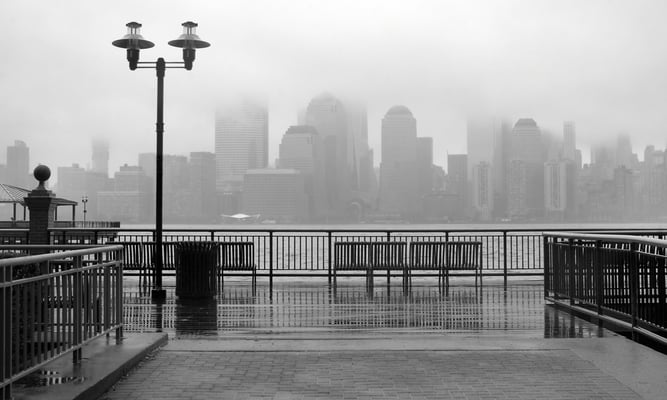Introduction to Resilient Design: What Is Resilience?

The term resilience describes the ability to adapt to changing conditions, and to maintain or recover functionality after a disruption. In simple terms, resilience is the capacity of recovering after a disturbance or interruption. With resilient infrastructure, communities can maintain bearable conditions in the event of power loss, natural disasters, or other interruptions of normally available services.
Resilient design is the process of designing buildings, landscapes and entire communities to mitigate the impact of extreme weather and other external threats. Resilient design focuses on practical and realistic solutions.
Use a resilient design for your next building project.
Resilient Design Principles
Resilience applies at all project scales: Resilient design strategies are applied to individual buildings, communities, and larger regional scales. Resilience also applies for several time scales, from immediate to long-term.
Basic human needs are fulfilled in resilient systems: Sanitation, potable water, energy, lighting, air quality, food, health, and livable conditions.
Simple systems are more resilient: Systems with a simple design that suits their application are more resilient that overly complex systems with demanding maintenance requirements.
Durability: Strategies that increase the durability of systems also improve their resilience. This applies for buildings, public infrastructure, and ecosystems.
Local resources improve resilience: Using local resources like solar energy and groundwater provides greater resilience than depending on external or non-renewable resources.
Resilience anticipates interruptions: Constant adaptation to a changing climate and other natural events such as earthquakes is a growing necessity. Responding to change is an opportunity for building improvements.

Learn from nature: Natural systems have evolved to achieve resilience. Therefore, applying lessons from nature is a way to enhance resilience, combined with strategies that protect natural environments.
Social aspects of resilience can be as important as physical responses: Communities that are diverse but unified will fare better during times of crisis or despair.
Resilience does not end: Achieving resilience is a constant process of taking incremental steps, applying what is feasible in the short term and working from there.
Resilient Design Strategies
Resilience is not a single solution or design measure. Resilience must be understood as a multifaceted lens, which requires being proactive when creating solutions for disruptive events. In other words, resilient design involves a complete rethinking of the built environment. Below is a list of some practical strategies to improve resilience, remembering that each project is different:
Resilience at the Building Scale
- Design and construct buildings to withstand extreme weather, such as severe storms.
- Critical systems should be located in areas that are unaffected by flooding and other extreme weather events.
- Past records of the climate can help understand the behavior of a region. However, designs must consider future weather conditions as well.
- Design buildings that maintain livable conditions in case of an extended power loss, or and interruption of heating fuel deliveries. This can be accomplished with passive heating and cooling techniques, along with other energy efficiency measures.
- Design durable buildings with elements like rainscreens, waterproof interior finishes, impact resistant windows, etc.
- Install systems with manual overrides, in case of malfunction or power outages.
- Deploy on-site renewable energy and use it as efficiently as possible.
- Promote water conservation practices such as rainwater harvesting or greywater reuse.
- Learn about product hazards, and specify which materials or products will leak hazardous substances in the event of a flood or fire.
- Install redundant water supplies or water storage for emergencies.
- Install redundant electrical systems, with enough backup power capacity for critical devices and equipment.
- For cases where the municipal wastewater system is disrupted, consider alternatives to handle human waste. Some examples are waterless urinals and composting toilets.
Resilience at the Community Scale

- Design buildings that facilitate the personal interaction between neighbors, by adding more gathering places or common areas.
- Promote the use of local products and services.
- Implement green roofs and rainwater storage systems, to reduce the “heat island effect” and manage stormwater.
- Design physical infrastructure such as roadways and bridges to handle increased stormwater flows.
- Implement erosion control methods, especially those that integrate with nature.
- Create community facilities that can be used as gathering places during an emergency. Schools and other large structures offer suitable conditions for this. These facilities should be equipped with key services, such as water and electricity.
Resilience at the Regional Scale
- Promote the use of regionally manufactured products. Governments can help with incentives such as cash rebates or tax deductions.
- Create regional and renewable power systems, improving the stability of the electricity grid.
- Develop or strengthen regional transportation services.
- Maintain and protect aquifers, through strict regulations that prevent contamination and overuse.
- Adopt policies that value, protect and restore ecosystem services, such as natural erosion control, healthy forest, water filtration, etc).
Resilient design can also help developers certify buildings with LEED and other similar rating systems. Energy efficiency, renewable generation and environmental impact reduction are all covered by the performance categories of green building certifications.

Michael Tobias
Michael Tobias, the Founding Principal of NY Engineers, currently leads a team of 50+ MEP/FP engineers and has led over 1,000 projects in the US
Join 15,000+ Fellow Architects and Contractors
Get expert engineering tips straight to your inbox. Subscribe to the NY Engineers Blog below.



